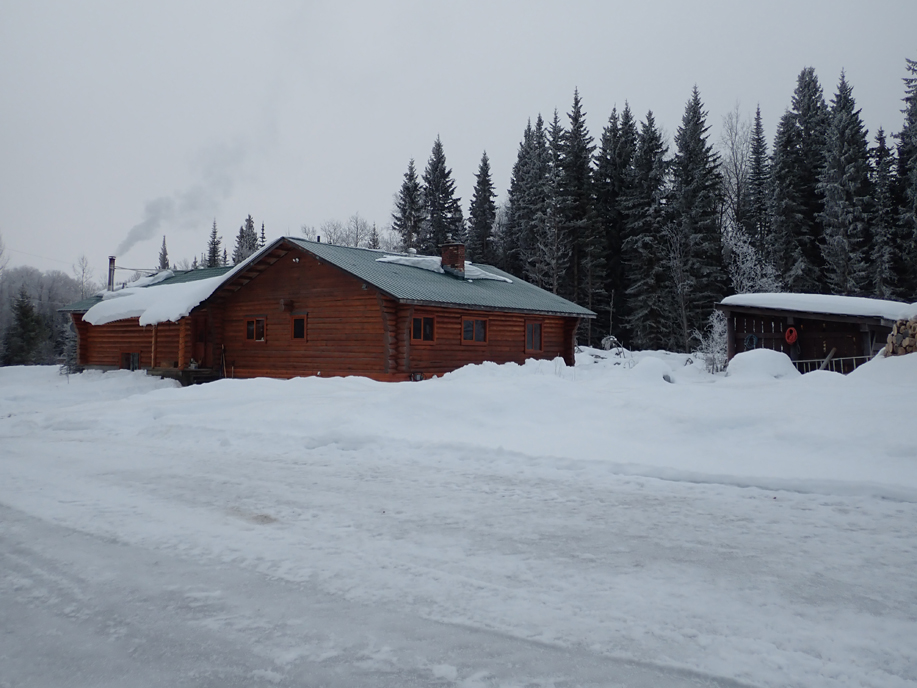

I like living in central British Columbia: aside from living well apart from other folks, BC has four seasons. Admittedly, they aren’t all of equal length: Winter is the longest, and with its short days, snow, and cold, it's refreshing to go off to someplace warm(er) for a bit in the middle of a tough season. It really doesn’t take much, just a trip over to Vancouver Island or down to the Great Basin will do. Other places do beckon, though.
IN THE BEGINNING
Wildlife management is based on the concept of species evolution (while Charles Darwin gets all the credit for this unifying theory of life, Alfred Wallace made his contribution as well). On his famous voyage aboard HMS Beagle Darwin pondered the variations he saw in otherwise-similar species from one island to the next in the Galapagos chain, and eventually developed the concept of change driven by adaptation to local conditions.
So when Wini mentioned the Galapagos Islands, I, as a terrestrial ecologist, immediately brought to mind huge tortoises, finches, iguanas, and the various other animals that got ol’ Charlie to pondering why and how these came to be so different from one place to the next. I said, “Sure. When?”
And it was winter in BC: the Galapagos are Ecuadorian territory and the country gets its name from the imaginary zero line for latitudes. It would more than fill the bill for a short escape from cold and snow. The tag end of January and the first few days of February were perfect.
A week and a bit aboard a small motor sailer sounded good. I’m not an overly gregarious guy and with a limit of 12 other tourists I knew I could deal with it. The boat would be hotel and restaurant and we’d get to go visit several islands. Well, really we’d get to visit the vicinity of several islands. On reflection the restrictions: I understood that battalions and regiments of armies of tourists would, no matter how careful they might be, swiftly trash the habitat of the unique species found there. Oh, we’d get to walk on dry land occasionally, but only in areas already modified, such as tortoise breeding pens, pre-existing settlements and the like. Most of our touristing would be done afloat.
With suitable care on the part of the visitors and steady washing by the ocean currents the multitudinous reefs could sustain a lot of viewers without undue damage. And as for the tour operator allowing damage to occur, the penalty of expulsion ensured that adequate care was taken. The apparent drawback was that such touring was mainly done while snorkeling. I had learned the basics of snorkeling a long time back, courtesy of my Uncle Sam. While I never had to use it or the associated diving instruction, after I learned it, I do remember it as an uncomfortable experience. Not the water, for I had long before learned to swim, but the equipment.
It was an irritant at best. I suspected at the time that it had been salvaged from Mike Nelson’s locker of discards. The mask was a black rubber thing that had to be strapped tightly to my face lest it leak around the edges; the rubber had all the flex of a cop’s truncheon, so after about five minutes it was cutting deep red grooves into my skin. The snorkel had no flex, being nothing more than a long section of PVC tubing with a bend in it. The mouthpiece wasn’t any more flexible than the mask’s skirt. The length of it was to keep it high enough above water level that water wouldn’t slop into the top. If it did, you had to snort violently through it to get the water out and let the air in. You had to really blow through it every 10 or 15 minutes to clear out the CO 2 build up that collected in the long snorkel from regular breathing. The flippers were about the same as current ones, but because I have feet smaller than most boot makers’ minimum size, they chafed me badly. At the end of a snorkeling session I hurt at both top and bottom. The bottom—my feet—hurt from the chafing of the fins; and the top—my mouth— ached from gripping the oversized, inflexible snorkel mouthpiece. After nigh a half century, I wasn’t looking forward to a repeat of the experience; but at least the boat had kayaks available.
A web search quickly informed me that snorkeling gear has changed much over the past four and more decades. It also emphasized that the gear, especially mask, fins, and, snorkels must fit. The boat we were contracted for advertised the availability of snorkeling gear aboard. That option wasn’t an attractive one. My wife and I are approximately the same size; I’m small, she’s feminine tall, and neither of us are toting much excess avoirdupois. To top it off, I wasn't sure I wanted to shove a snorkel into my mouth, one that had been used by innumerable people ahead of me. I have enough health problems of my very own and no need to borrow others’; and I’d not wish the same possibility on Wini. We really did need to get our own basic gear: snorkel, mask, and fins. We’d pass up a couple of nights out and that would more than fund it. There were reviews suggesting this mask or that snorkel, and these fins over those, but I knew we needed to look at and try them in analog reality and not virtual reality. Dive shops are in short supply where I live, which is over 500 miles from the coast and about half that far from the nearest large lake.
SERENDIPITY STRIKES
When I retired, I retired (mostly). When Wini retired, she was more than willing to exchange one paid job for another—OK, several—unpaid ones. I've lost count of the number of committees, boards, and suchlike that she’s on; the list uses up more letters than the latest groups begging for recognition in the legion of Victimhood. All of the jobs she's taken on, of course, are conservation related, so my frequent bachelorhood as Wini jets off to attend some meeting or another is in a good cause. But finally one of those meetings resulted in something useful to both of us: a trip to a dive shop.
The Canadian subsidiary to the Wildlife Society gave Val Geist an appropriate award for lifetime achievements. For reasons I disremember, if I ever knew them, Val was unable to attend the awarding ceremony (don’t we wish we could do that at our funerals?). Wini volunteered to go deliver it to him in person, so the twain of us packed up the dog and made a road trip to do that, because it just seemed a bit crass to send it by mail. We passed through Vancouver on the way. There are several dive shops in Vancouver, so we decided to make a minor detour.
There were two guys in the shop and it immediately felt good; both of them were my age or older. I like my computer people to all be young, I could give a rat’s ass about the barbers, but when getting information (and spending money) about something that involves real expertise and experience, I want their hair to be gray. Learning by experience tops learning by internet.
After looking at various bits of mysterious stuff, discussion with the guys, pertinent questions asked and answered, we left with the basic gear. It was nothing like the gear I’d learned with, even though they had some of that stuff available “for those old farts that can’t figure out that older isn’t necessarily better.”
The fins were easy: open-heeled fins of a size small enough to be readily packed, and with a foot well big enough to be snug on the neoprene booties we got with them. The mask was another matter. While Pamela Anderson and multitudinous others have found uses of silicon, so has the diving world, though those uses are somewhat different. There are now soft mask skirts, snorkel mouthpieces and other bits and pieces that contribute to swimmers’ personal comfort. Hmm....reflecting on PA and others, there might be a connection there.
Everything fit, as well as could best be determined in a store, and we were left with one final warning. “If that balm doesn’t do the trick, guy, you’ll just have to shave.” As pliable as silicon might be, asking it to seal the mask’s skirt against the stiff hair—How stiff? Electric shaver motors last about six months against it—might be a bit much, even with the assistance of reef-friendly grease smeared on the ‘stache to cover the small gaps betwixt skirt and lips.
ADDITIONAL GEAR
I've sacrificed a few cameras to the Water Gods over the years. In addition to the simple monetary loss and the loss of any photographs in the camera—although with the advent of digital technology all photos are not necessarily lost if the camera is recovered—there is also the more important loss of any ability to take pictures during the rest of the trip. I really liked my normal Lumix travel camera, but I knew it was highly susceptible to water damage. A day in a mountain storm in the Lakes District of Great Britain taught me that: the camera recovered from that trip, but the plastic bag that I'd stowed it in on a recent moose hunt failed when I swamped the canoe, making that Lumix another sacrifice to the Water Gods. Moral: If your camera isn’t waterproof, get a waterproof carrying case; don’t trust plastic bags to do the job. I decided to replace the Lumix rather than just give up all photography. Just in case, and to make it a pair of suspenders to go with the belt, I got an Olympus waterproof camera. The zoom lens was a mere 4x (not much by today's standards) but the ability to be used underwater outweighed any drawback. Besides, it takes very little turbidity to negate any more need for telescopic power in ocean water so the 4x wasn't a big deal.
Along with snorkeling gear, we bought a nylon mesh bag with carry straps (like a flimsy day pack) for carrying our wet or sandy gear around. The good ship Samba carries 14 passengers. Add in a guide or two snorkeling with us and that adds up to nearly three dozen individual flippers, 16 or so masks, and other assorted gear piled on the deck when we get back aboard. To identify our kit from anyone and everyone else’s I used an indelible marker to put our initials on all our gear. I even added a small keyring fob on a big split ring to the mesh of our carry sack to identify it from others that it might get stacked with. None of this was to prevent theft, but rather to make it easier to identify and separate our own gear from that of others or the boat’s.
 My memory is fallible, and gets moreso with the passing years, so I take notes of my (mis)adventures. Once upon a time I had a good memory; I had to have one because my handwriting was laborious, slow, and nigh indecipherable, so trying to take class notes was a forlorn effort. One of the good things that Uncle Sam forced me to learn was touch typing, and I’ve maintained my facility with it. I can certainly type a lot faster than I can scribble. Accordingly, I travel with a small tablet computer and a bluetooth keyboard. I can set that up and get my notes down. Even with a few missed licks in the bluetooth signal and the odd typo, I can still easily decipher my notes. Computer gear is like camera gear, it doesn’t like water. I brought some silica gel and some plastic bags to store my gear in when I wasn’t using it. A boat is a damp place, and the humidity is even higher when the occupants are hanging wet clothes around the cabin, so the desiccant was to prevent malfunctions.
My memory is fallible, and gets moreso with the passing years, so I take notes of my (mis)adventures. Once upon a time I had a good memory; I had to have one because my handwriting was laborious, slow, and nigh indecipherable, so trying to take class notes was a forlorn effort. One of the good things that Uncle Sam forced me to learn was touch typing, and I’ve maintained my facility with it. I can certainly type a lot faster than I can scribble. Accordingly, I travel with a small tablet computer and a bluetooth keyboard. I can set that up and get my notes down. Even with a few missed licks in the bluetooth signal and the odd typo, I can still easily decipher my notes. Computer gear is like camera gear, it doesn’t like water. I brought some silica gel and some plastic bags to store my gear in when I wasn’t using it. A boat is a damp place, and the humidity is even higher when the occupants are hanging wet clothes around the cabin, so the desiccant was to prevent malfunctions.
Always get a spare battery or three, and a charger for cameras and any other electronic gear that has a removable battery. When the battery conks out in the middle of a tour, if you have a spare, you can replace it easily. But that spare has to be charged and using your camera or whatever as a charger for hours can be extremely frustrating.
GETTING THERE
The planning for this trip was relatively easy, even from central British Columbia. We know how to get to Vancouver; there aren’t many options and we know them all. The question was how to get from Vancouver to the Galapagos on some sort of reasonable schedule and at an acceptable price. We would, if forced to, travel through the USA but that is a hassle to be avoided whenever possible. Air travel is stressful enough without adding in the humiliation and harassment that the Travel Sturmabteilung and various versions of border guards feel that it's necessary to inflict on anybody and everybody. AeroMexico filled the bill with a Vancouver to Quito flight that had one modest layover at Mexico City. The flight from Quito to the Galapagos was arranged by the cruise company, so that end was already arranged.
Both AeroMexico and the contract flight on to the Galapagos had size and weight restrictions, nothing more onerous than normal, on the baggage. It was the Samba, our boat, that had the final restriction of no hard side luggage. That bothered me not at all; I’ve been too much time on too many boats to be ignorant about the cramped spaces. One thing that made it almost easy was that the equatorial weather would be warm, so there was no need for heavy winter clothes and boots. The clothing for our touristing in Quito going and coming wasn’t extensive either; were weren’t invited to any fancy dress balls.
PACKING
Our tour boat, the Samba, was small: not quite 80 feet long and carrying 14 passengers maximum. Accordingly the cabins were far too small to dignify with the term "stateroom." There would be no need for evening wear, morning clothes, or anything more than clothes for active wear. Even the meals were casual, served family style in the dining room—a place that also did duty as the briefing room and evening lounge. Since airlines have gotten predatory regarding excess baggage, and since we’d have to lug all our gear in and around airports, onto island transport, then to the motor launches and aboard the boat, minimalist packing was necessary, both in weight and bulk. Finally, shit happens. As the guy who invariably finds the pit in his piece of cherry pie, I know that the one-in-ten-thousand rogue wave that sweeps into the launch as it is 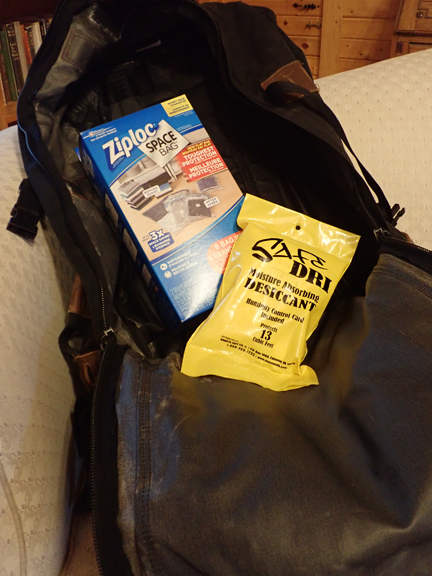 being loaded will happen when my suitcase is at the bottom of the boat.
being loaded will happen when my suitcase is at the bottom of the boat.
For my main suitcase, I used one that predates luggage with wheels. It has built in pack straps so it can be comfortably carried like a backpack. Inside that, I used "space bags," a Ziploc product that is nothing more than an oversize baggie with a purge valve. You put your clothes in it, zip it shut, then either use the (provided) straw to suck the air out of it or simply roll the clothes, bag and all, and force the air out the purge valve. The one-way valve doesn’t let the air back in so the bundle takes up a minimum of space; this is especially appreciated when packing fluffy fleeces and sweaters. Wait, you say: I’m headed for the equator, right? yes, Quito, the capitol of Ecuador, is on the equator, but at over 9,300 feet in elevation it is still cool to cold. It hasn’t warmed up any since I first read about how cold it was in Harry Franck’s 1917 book, Vagabonding Down the Andes.
By packing judiciously with nice trousers and shirts in one, underclothes in another, and swimsuits and associated gear in yet another, all my clothes would be protected against dunking, sudden rainstorms and suchlike, and would be easy to put in the various drawers and lockers aboard the Samba. My electronic gear, batteries, spare SD cards, and other moisture sensitive gear got their own bag in my day pack that I’d use as my carry-on luggage. For the return trip, the same bags with added desiccant would be doing double duty.
That final morning of the trip comes. It is bright and cheery with the exciting morning snorkel; the last swim on this vacation. When you get back aboard the boat, you give the mask, snorkel, and fins a final rinse in freshwater. They’ll be dry and ready to pack by the time you’ve finished the celebratory late lunch. Not so your swim suit and rash shirt: you rinse them as you shower off the salt, then hang them from the boat’s laundry line. But the combination of humid sea air and the limited time before you have to pack for debarkation means that they’ll be—at best—damp, if not wet just a bit less than the drip stage.
You know better than to pack the swimsuits and rash shirt in with everything else because if you do, when you get to the night’s lodging everything else will be uncomfortably damp. So you pack them in a plastic bag. If, as so often happens to me, you don’t have any opportunity between last minute shopping, short nights at a hotel to catch an early flight, and all the details that encumber traveling to let the swimsuits and rash shirt dry a bit more, it’ll be several days and several time zones later before you can unpack them. And when you do, they might not obviously be discolored with the gray-green growths, but the smell will definitely speak of mold and mildew.
Unlike the smoky smells that emanate when unpacking from a safari and remind you of vistas seen and miles walked, the stink of the snorkeling clothes reminds you of nothing so pleasant. And that doesn’t include the unpleasant reminder that the synthetic fibers of your clothes don’t respond well to hot water and bleach, forcing you to give them repeated soaks in lukewarm water interspersed with bouts of hand washing with mild detergents to get them usable again.
I avoided the problem with the space bags and a desiccant pack. Not the tiny packets of silica gel that come inside the packaging with a new phone, the packets that say “Do not eat,” but large ones that are used to control the humidity inside gun safes. I went down to the local shootatorium and got them in big bags of eight or ten smaller packs. Firearms aren’t any more fond of moisture than electronics, so the large sized packages of desiccant are readily available.
In packing for a snorkeling (rafting, fishing, &c.) cruise I make sure that I have at least one spare space bag. I put in my less than dry clothes, toss in a desiccant pack, and squeeze out any extra air. When I get home, the clothes are mildew and mold free and ready for a final hand wash and hang drying before packing them away for the next trip. The desiccant pack has no toxic chemicals, so it just goes in the burn barrel along with the memories of how bad moldy clothes stink.
THE ACTUALITY
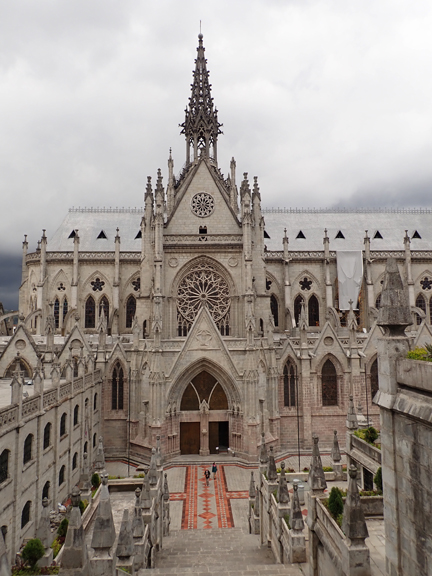 Harry Francke was right. Old Town Quito, which was the town as it existed in 1917, has more churches than you can count. And they ain’t Methodist, nor Adventist, nor any of the off-brands of Protestantism. How any religion can venerate torture is simply beyond me. At 9,300 and a bit more feet above sea level, climbing the multitudinous steps up to yet another cathedral to be greeted by a statue that competes with the statues of all the other cathedrals in its realism of a man in agony was something I didn’t travel a quarter of the way around the Earth to do. Unfortunately, there’s not a lot else to see.
Harry Francke was right. Old Town Quito, which was the town as it existed in 1917, has more churches than you can count. And they ain’t Methodist, nor Adventist, nor any of the off-brands of Protestantism. How any religion can venerate torture is simply beyond me. At 9,300 and a bit more feet above sea level, climbing the multitudinous steps up to yet another cathedral to be greeted by a statue that competes with the statues of all the other cathedrals in its realism of a man in agony was something I didn’t travel a quarter of the way around the Earth to do. Unfortunately, there’s not a lot else to see.
Quito does have longitude 0° 00’ 00” running through it. Of course, the French who surveyed it about the time the Alamo was besieged got it wrong, by about 300 meters or so. The actual equator is on private land and has a wonderfully hokey display there. The official display (at the wrong location) has a museum with solid scientific stuff, but it isn’t nearly so much fun.
After a day or so of playing tourist in the truly high lands, and appreciating greenery and flowers, we were off for a very long flight to the Galapagos. The touristing had begun.
We were greeted by the naturalist for the Samba. The airport for the Galapagos Islands is at sea level or thereabouts on either Baltra or Seymour Island, depending on whose map you use. From there a bus takes you on a 10 minute ride down to the narrow channel where a ferry takes you south to Santa Cruz. From there another bus takes you across the island to the southern tip where the Porto Ayora harbor is. But, our bus, more like an extended van, being filled with Samba people and a naturalist guide, stopped just over the height of land (not quite a thousand feet above sea level) for a tortoise tour.
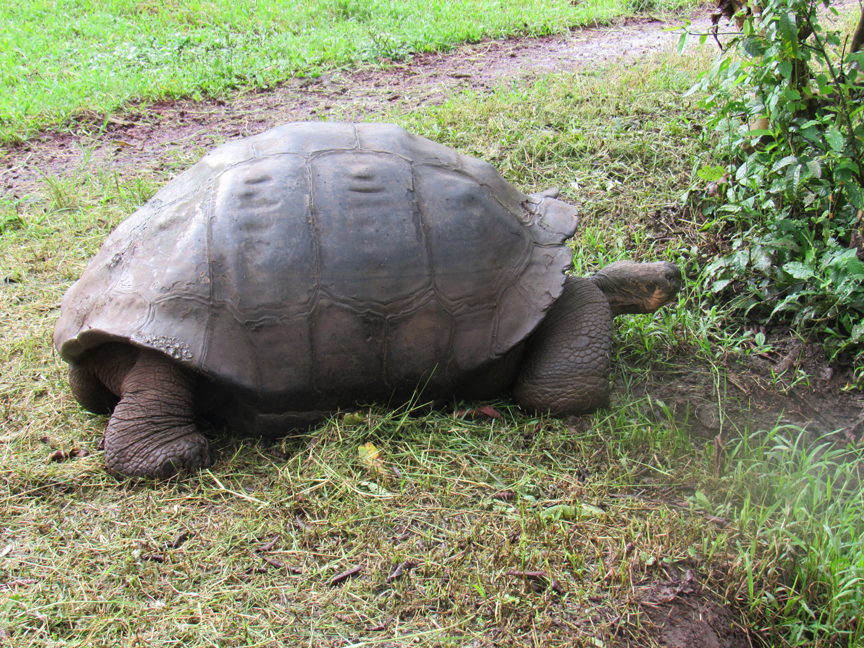
It was pouring rain. It was also around 80° F. For me, the choice was easy: did I want to get soaked with sweat under my rain coat or just let the skies water on me.? It didn’t seem to bother the tortoises so I didn’t let it bother me. A week and multiple islands later, those were still the only tortoises I’d seen.
After a short tour of Pto. Ayora that consisted of wandering around unescorted for a couple of hours, the complete contingent of the Samba gathered at a small dock where we boarded zodiacs and were taken off to our next week’s home.
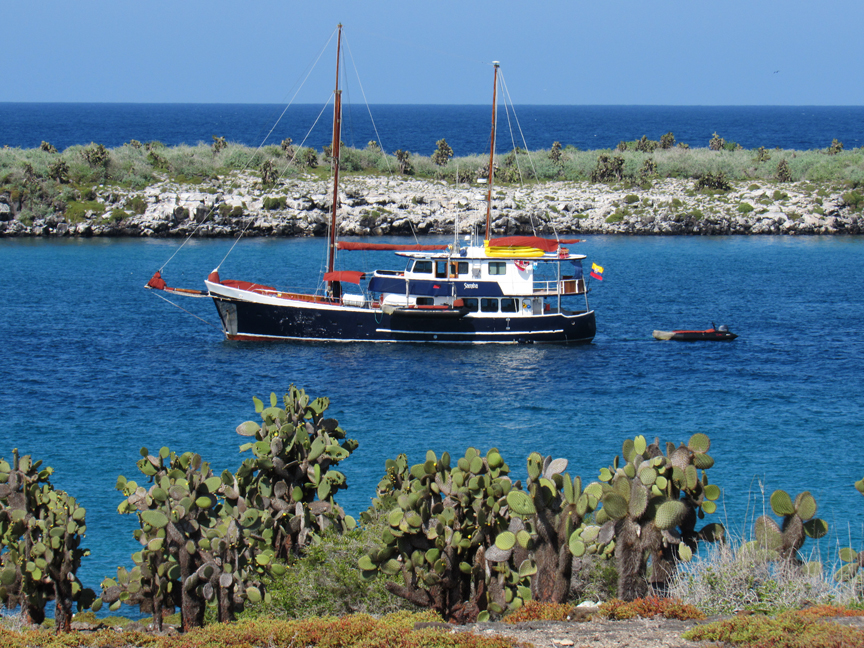
The 14 passengers were an interesting collection of Canadians (2, us), ‘Muricans (2, OR), French (2), Brits (2), Swedes, (2), and Germans (4). Half a dozen of us were in the 60+ range and the others were in the sub-40. English was the common language, although it took occasional translation into French by one of the polyglots to bring everybody up to speed. And the naturalist, required by the Galapagos National Park rules, knew his stuff and could handle it all in English without stumbling.
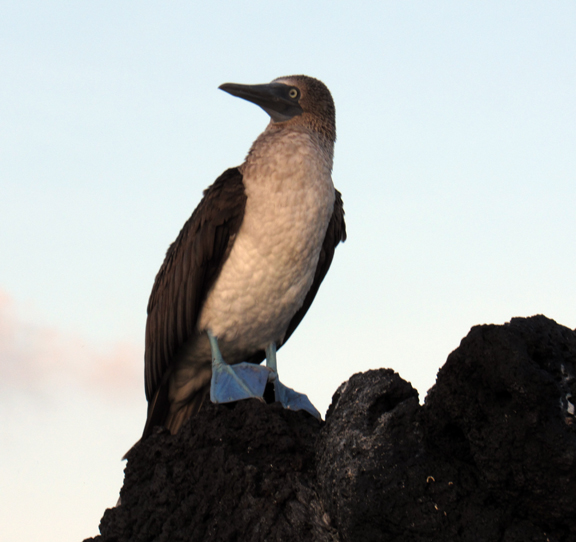 The days were busy; so busy that we started at sun-up. Equatorial sunrise was within a few minutes of 0630. After a before-dawn infusion of coffee, we were off on a short dinghy ride, usually to hike. That put us on shore when the wildlife was most active and when the lighting conditions were best for pictures. There were the standard species seen on any nature show like blue-footed boobies, sea lions, and iguanas.
The days were busy; so busy that we started at sun-up. Equatorial sunrise was within a few minutes of 0630. After a before-dawn infusion of coffee, we were off on a short dinghy ride, usually to hike. That put us on shore when the wildlife was most active and when the lighting conditions were best for pictures. There were the standard species seen on any nature show like blue-footed boobies, sea lions, and iguanas.
Come to think of it, there’s little to see that isn’t already familiar from the nature shows. Too often much of the wonder of the natural world is stolen by the excellent camera work: A close-up zoom image of a bird taken with a gazillion-dollar camera and displayed on the mind-boggling high-definition screens available cheaply at any appliance vendor is visually superior to the Mark I eyeball at 25 paces. One has to really, really want the added effects of gnats buzzing around, wind snatching at one’s hat, and the ineffable stink of Galapagos sea lion excrement mixed with the nose-clogging guano odor of a nesting booby colony to be able to appreciate the reality.
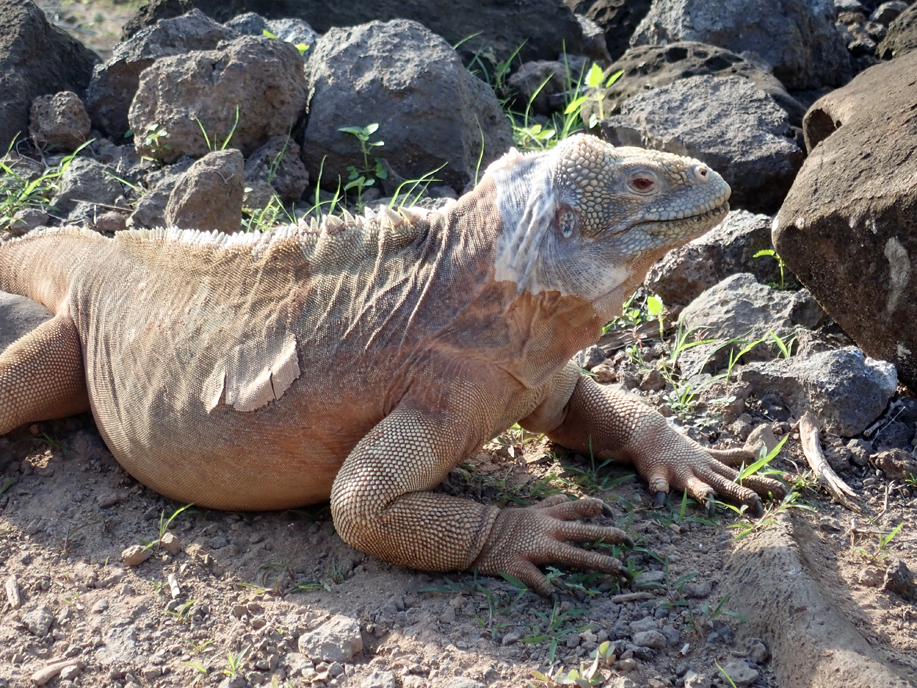
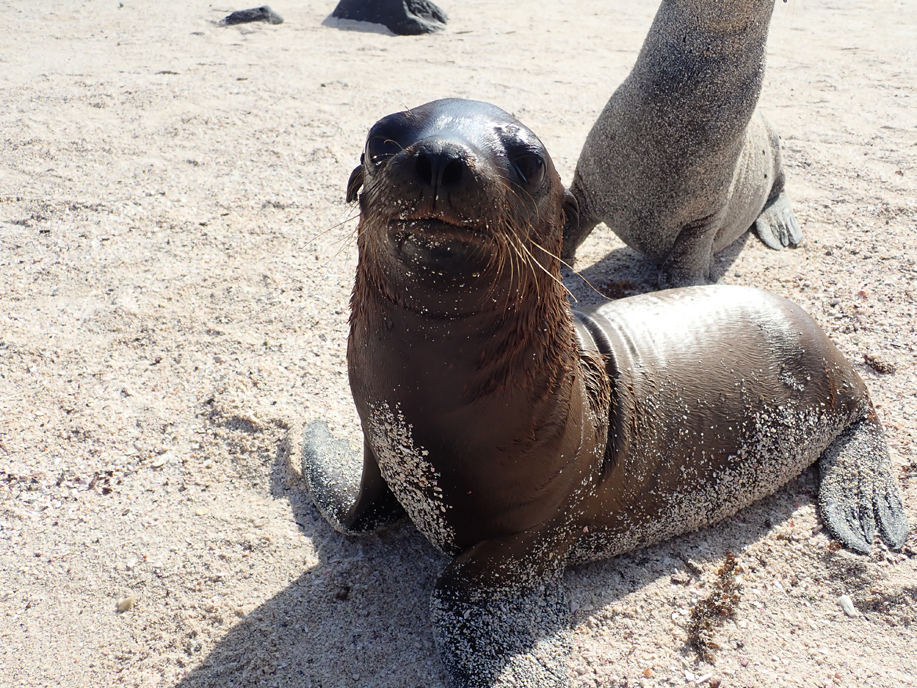
More common than the iguanas were the lizards. These were not the spiky-backed 1950s movie stand-ins for dinosaurs, but the small-scaled, slick-hided lizards not much different from those you’d see anywhere in North America south of 50°N. As with about anything terrestrial in the Galapagos, nobody is quite sure how they got to the islands, but they’ve been there long enough that the varieties on the different islands are different species. It turns out that they all look pretty much similar, but they have different “languages.” Their head-bobbing and displays have diverged sufficiently that when lizards from different islands are caught and caged together, they don’t understand each other well enough to mate, although there appears to be nothing physical that would prevent them.
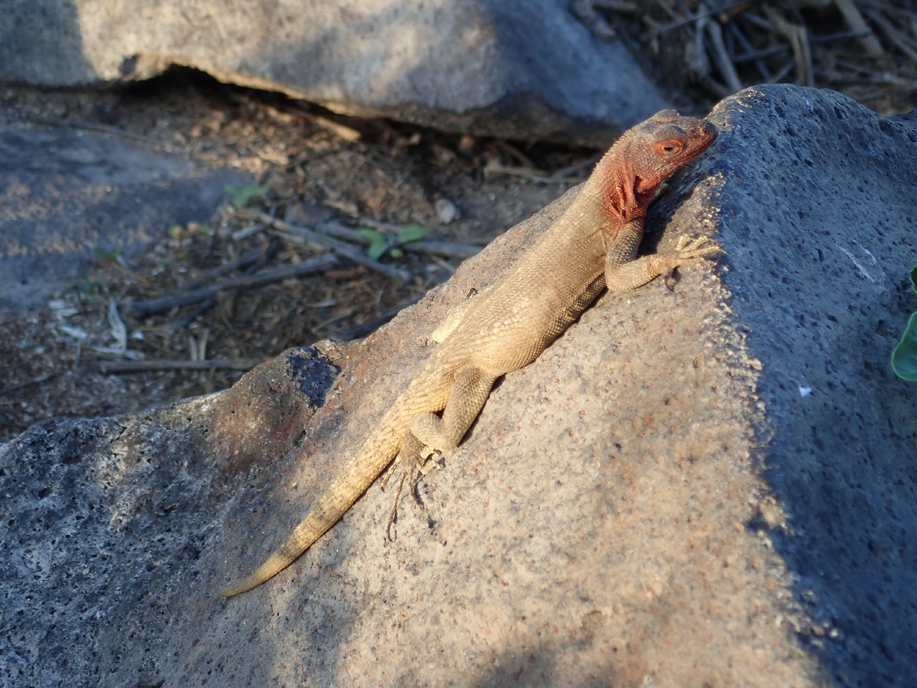
After the hiking, never arduous but getting hotter all the time, it was back to the Zodiacs for the ride back to the Samba for breakfast. An excellent, hearty breakfast, as were all the meals. It was only the long day of activity and exercise of self control that prevented everyone from leaving several pounds heavier than when they arrived.
Perhaps the ocean acts differently from a swimming pool or lake. I well recall that it took a full hour, not just 58 minutes, before we were allowed into the water when I was a lot shorter and younger than I am now. The indeterminate time between wandering down to the cabin, getting into swimming clothes, wandering back out on deck, squirming into wetsuits, slathering sunscreen on the uncovered portions of our skins, and such small details was perhaps sufficient to prevent us from getting the bends, cramps, fantods, or whatever it is that besets a person who enters the water within an hour of eating.
Once we were all properly suited up, we clutched our bags of snorkels, fins, and masks, climbed into the dinghies and took the short ride to where we’d be snorkeling. The water was warm, in the high 70°s F, but a wetsuit was still necessary if we were going to spend an hour and more in it. The first snorkeling location on the first day was probably the best one, with the greatest diversity of fish and the most extensive shallow water. The Galapagos Islands are volcanic and the reefs are lave reefs coated over with barnacles, urchins, and other wondrous forms of aquatic invertebrates. The coral reefs of classic snorkeling expeditions are all thousands of miles away. And I missed even this tiny taste of it.
The guys at the dive shop had done their best to kit me out with a mask that would, when assisted by liberal applications of lip balm gel, seal against my mustache. Alas, I had to clear my mask in the first five minutes and the act of snorting the water out stressed the seal and it leaked even more. I went back to the Zodiac where the driver, Freddy, had a Samba-provided tub of Vaseline for us hirsute folk and applied that. Again, about 5 minutes of sealing was all I got. There was simply too much hair growing under and alongside the lower edge of my nose for the silicon skirt to seal up. That first snorkel stint was, from the wee bits I saw between bouts of clearing my flooded mask, fantastic. Back aboard the Samba I heard a lot about how great it was. I had a warming cup of coffee and went to my cabin.
I stood in front of the mirror with my tiny scissors (How tiny? They’ve passed through several Travel Nazi inspections) said goodbye, and went to work. The scissors weren’t able to handle a lot of it, so it was up to the razor to deal with it all: hairs trimmed, hairs untrimmed, and everything. After a dozen and more years, my upper lip was pretty tender when I got done. I’ll never be an object of beauty, but coming from over four months of Canadian winter, any tan my face had was gone, so there was no white patch announcing the fresh vacancy: at least I was spared that. The lunch bell rang not long after I finished.
It was only the first day, so we weren’t all familiar with each other; faces or names. Wini is pretty hard to mistake and when I sat next to her, the pennies started to drop. The various reactions were actually pretty funny. Not so funny that I’d have shaved off the ‘stache for it, but as a side benefit, they were amusing. Of course, they’d seen the mustachioed me for only a day and by the time Day 3 rolled around, they were more used to my shaven face than my mustachioed one, so the social disruption was minor.
Lunches were no less flavorful and expansive than breakfasts. I’m used to a sandwich with a couple of pickles on the side. A starter of soup, followed by meat and or fish along with South American starches and veggies, and chased down with pie or pudding was simply too much. I was unable to hold up the Canadian end of things, but I wasn’t the only one who passed along some of the dishes as they came by simply because the volume was overwhelming. However, nothing went to waste. Whatever the Frenchman (seriously, his name was Pierre) failed to eat, was either repurposed in soups or something, or used as trading materials.
The local fishermen, usually two to a 18-foot skiff with a Japanese-made 100 or so horsepower outboard hung on the end, would pull alongside and trade. Angel, our cook, would trade them a mountain of leftovers plus a soda or two in exchange for the catch of the day. All of the Samba’s crew from the Captain on down were native Galapagossians and so knew all of the fishermen. They ate well, we ate well, so there was no room for complaint.
After some duration which was deemed to be an hour had passed, we were off on another snorkeling bout. It was purportedly the rainy season in the Galapagos, but the Galapagos Islands are mostly like the Big Rock Candy Mountain; it only rains at night, and then only in the center of the larger islands. The days on the ocean were sunny, breezy, and hot. My swim trunks that had come off on our return from the initial snorkeling bout and been hanging in the breeze from an upper deck line, were dry. The wetsuit was clammy, but easier to get on from being slightly wet than it had been that morning when completely dry.
When we’d rinsed off our gear after the initial snorkeling session, I’d taken extra care to wash off the remnants of mixed lip balm and Vaseline that lined the lower skirt of my mask. When the zodiac stopped a full hundred yards off the island’s shore, the naturalist said that we’d be going from the deep water to the rock wall of the island and then along that.
The purpose of using the dinghy in the deep water was to give us the chance to see sharks. I didn’t want to see sharks. I didn’t want to be in water that had sharks. I’ve seen Jaws and I’ve read the book. It is one thing for me to carry a gun and wander where there are grizzly bears, or even where there are tigers, but in open water when I am completely at the mercy of the whim of an overgrown guppy with big honking teeth is another matter. I got in the water anyway. And my mask didn’t leak.
Many of the snorkeling destinations around the world emphasize the clarity of their water. This isn’t true of the Galapagos. The water isn’t polluted: it just has features that detract from its clarity. One of the things that makes the Galapagos a special place is that it sits at the confluence of four or more major ocean currents. Each of those currents brings in its own minor detritus from far, far away, and when those currents collide, as they do at the Galapagos, they stir up the waters near the point of collision. Visibility through the water in many places in the world is measured in yards. In the Galapagos, the visibility is measured in feet. When floating, kicking very lightly to not leave much of a pressure signature on which sharks home, you can see down 30 feet or so. The sharks are down there at 30 yards or so. Sharks are a pursuit predator, like a cheetah, not an ambush predator like an ant lion. I was completely aware of how fast a shark could cover the distance from 30 yards away—where I couldn’t see—to 30 feet away, where I could. The rocky shore was a welcome sight; I could see the bottom and there were no sharks there.
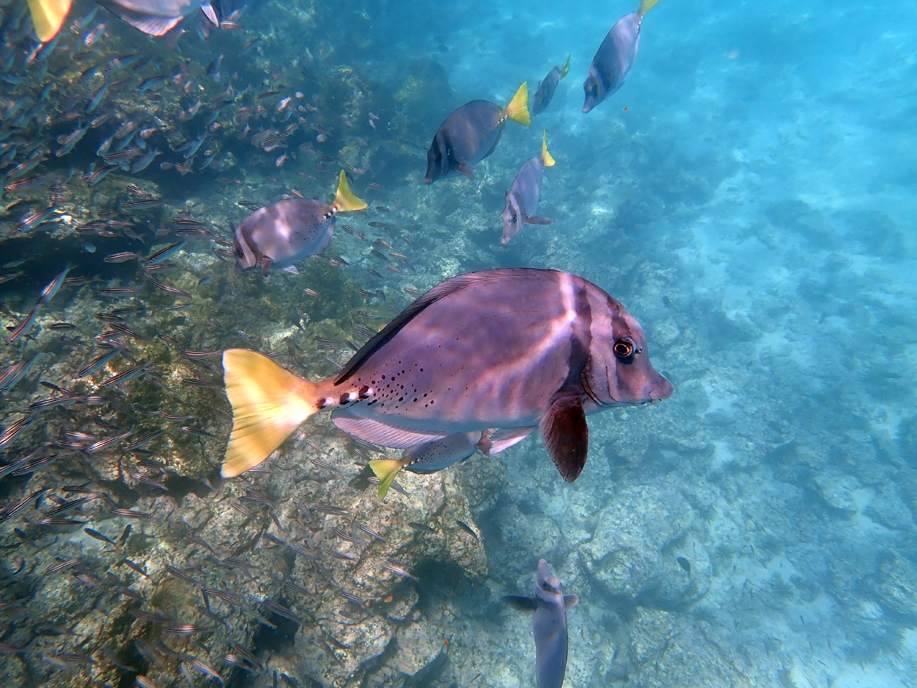
When we got into the shallows near the islands, the variety of fish wasn’t all that wide, but they were plentiful. None of the fish were isolated to specific islands, but several were endemic to the Galapagos in general and not found anywhere else. Unfortunately, my fish identification abilities aren’t well developed. I was too often unable to identify just what species I’d seen when I got back to the Samba and looked in the picture books unless there were distinct markings, as in the razor surgeonfish.
Occasionally we’d see octopus, sea turtles, and other aquatic creatures. The sea lions generally ignored us. Their major predators are the sharks and the sea lions put the bum’s rush on any sharks that wandered near their young, for which I was grateful.
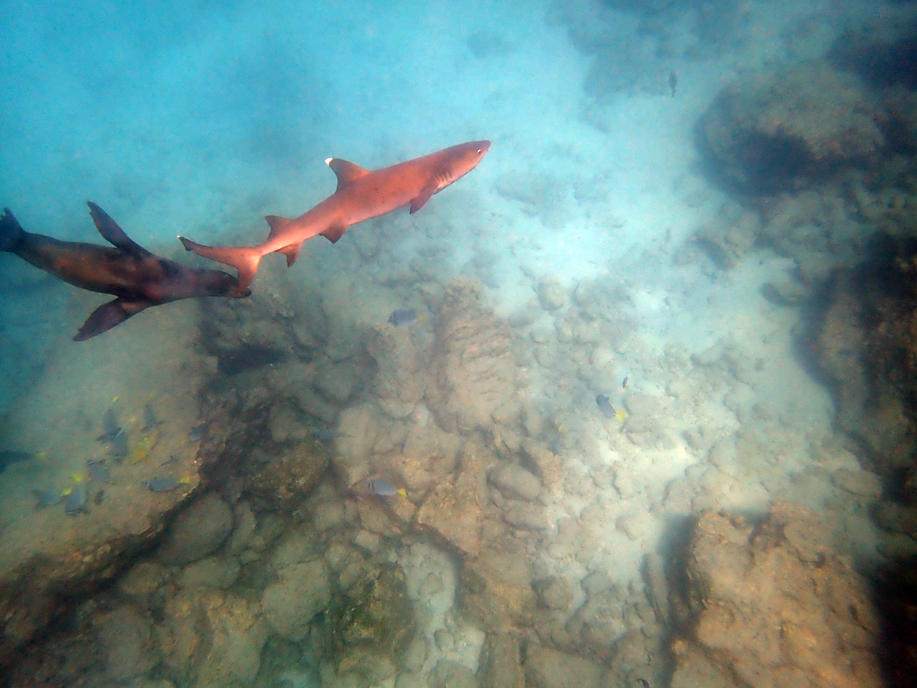
That was generally the daytime routine: An early start and activities all day long. The hikes were all different in detail, but similar in general. Each beach landing was greeted by Galapagos sea lions but was also a geological lesson.
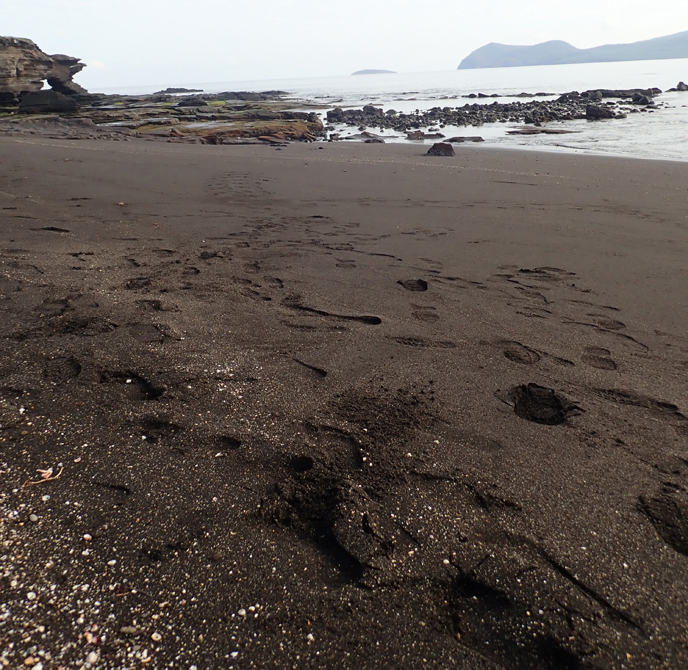 The Galapagos Islands were formed by upwelling lava and when each island was built, plate tectonics shifted it out of the way to weather, erode, and eventually disappear, the vacant spot over the upwelling then collecting the lava for another island. The islands at the western edge of the archipelago are the youngest, a mere million or so years old and the ones at the easternmost edge are thirty times that. After thirty million years or so, the islands tend to disappear beneath the sea. Although rare now, there must have been some significant coral reefs adjacent to some of the islands at some past time. The beaches were white; the eroded remains of the coral that had been there. Usually the beaches were tan, brown, reddish, and even nearly black, depending on the composition of the lava that formed the island.
The Galapagos Islands were formed by upwelling lava and when each island was built, plate tectonics shifted it out of the way to weather, erode, and eventually disappear, the vacant spot over the upwelling then collecting the lava for another island. The islands at the western edge of the archipelago are the youngest, a mere million or so years old and the ones at the easternmost edge are thirty times that. After thirty million years or so, the islands tend to disappear beneath the sea. Although rare now, there must have been some significant coral reefs adjacent to some of the islands at some past time. The beaches were white; the eroded remains of the coral that had been there. Usually the beaches were tan, brown, reddish, and even nearly black, depending on the composition of the lava that formed the island.
After eight days of warmth and exercise, the Samba dropped up off at the ferry dock between Baltra and Santa Cruz Islands for the short bus ride back to the airport. I ignore comments about how I must have enjoyed the “once in a lifetime trip.” I’m not dead yet and there’s still the western half of the archipelago to visit.
| HUNTING | GUNS | DOGS |
| FISHING & BOATING | TRIP REPORTS | MISCELLANEOUS ESSAYS |
| CONTRIBUTIONS FROM OTHER WRITERS|
| RECIPES |POLITICS |